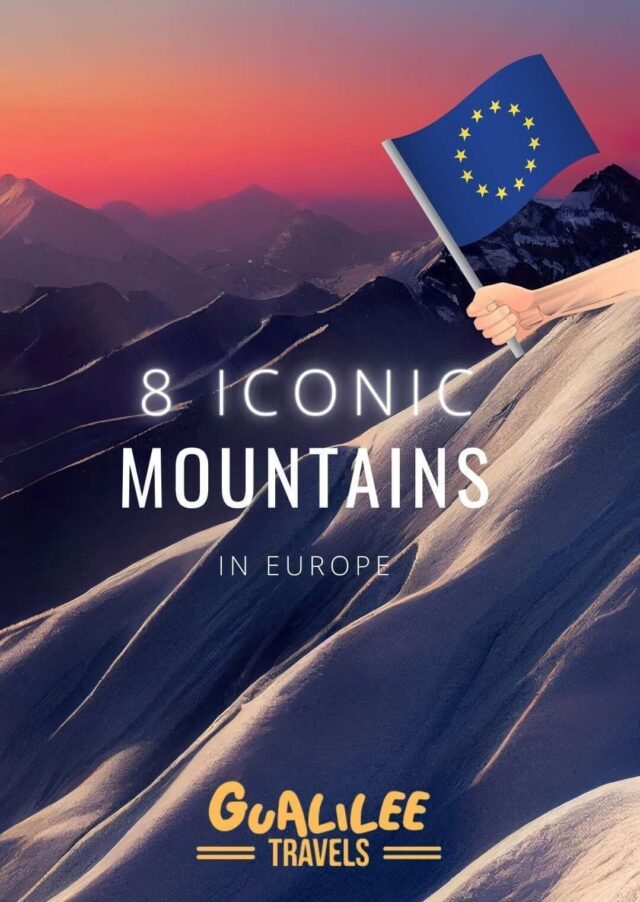The mountain ranges of Europe are timeless guardians of the continent, their snow-capped peaks standing sentinel over valleys, forests, and ancient trails. They have long inspired adventurers, artists, and poets alike, each drawn to the enigmatic beauty and untamed power of these natural wonders. For those who yearn for the touch of the clouds and the whisper of the winds, Europe’s mountains offer more than just breathtaking views—they provide a profound connection to the earth’s oldest rhythms. This article journeys across the continent to explore eight of Europe’s most iconic and unforgettable peaks, each one a testament to the continent’s diverse and awe-inspiring landscapes.
1. Mont Blanc, France/Italy: The Giant of the Alps
Rising with regal authority, Mont Blanc is the highest mountain in Western Europe, its snow-clad peak piercing the sky at an awe-inspiring 4,808 meters. Straddling the border between France and Italy, Mont Blanc is not merely a mountain; it is a towering symbol of the Alps, embodying both the majesty and the mystery of high-altitude life. Its name, meaning “White Mountain,” reflects the perpetual snow and ice that cloak its upper reaches, creating a stunning tableau visible for miles. The history surrounding Mont Blanc is rich and varied, from the pioneering ascents of the 18th century to the establishment of Chamonix as a premier mountaineering hub. Today, Mont Blanc remains a coveted prize for climbers and a source of endless fascination for those who simply stand in its shadow, marveling at its grandeur.
2. Matterhorn, Switzerland/Italy: The Pyramid of Nature
Few mountains are as instantly recognizable as the Matterhorn, its near-symmetrical pyramid shape cutting a dramatic figure against the sky. Located on the border between Switzerland and Italy, this iconic peak rises to 4,478 meters, commanding attention with its sharp ridges and steep faces. The Matterhorn’s striking appearance has made it a symbol of the Swiss Alps, a mountain as much defined by its beauty as by the challenge it presents to climbers. The ascent of the Matterhorn is steeped in mountaineering history, with the first successful climb in 1865 ending in both triumph and tragedy. Despite its daunting reputation, the Matterhorn continues to draw climbers from around the world, each one captivated by the mountain’s allure and the promise of adventure that lies within its rugged contours.
3. Ben Nevis, Scotland: The Sentinel of the Highlands
At 1,345 meters, Ben Nevis is not the tallest of Europe’s peaks, but it holds the distinction of being the highest mountain in the British Isles. Nestled in the heart of the Scottish Highlands, Ben Nevis stands as a sentinel over a land steeped in history and myth. The mountain’s Gaelic name, Beinn Nibheis, is thought to mean “Venomous Mountain” or “Mountain of Heaven,” reflecting both the treacherous weather conditions that often cloak its summit and the awe it inspires. The paths that lead to the summit are well-trodden, yet the journey remains a rite of passage for many, offering a glimpse into the wild, rugged beauty of Scotland’s landscapes. On a clear day, the view from the top stretches out over a vast expanse of lochs, glens, and distant peaks, a panorama that captures the soul of the Highlands.
4. Mount Elbrus, Russia: The Roof of Europe
Mount Elbrus, at 5,642 meters, reigns as the highest peak in Europe, earning it the title of the “Roof of Europe.” Located in the Caucasus Mountains of Russia, this dormant volcano is a giant of the continent, both in stature and in the challenge it presents to climbers. The twin peaks of Elbrus rise above a landscape of glaciers and snowfields, offering a formidable yet rewarding ascent for those who dare to scale its icy slopes. The mountain’s remote location and harsh weather conditions add to its mystique, making it a destination for experienced mountaineers seeking to test their limits. Yet, beyond the physical challenge, Mount Elbrus stands as a beacon of natural beauty, its summit offering a panoramic view that stretches across Europe and into the distant lands of the east.
5. Grossglockner, Austria: The Pinnacle of the Eastern Alps
Austria’s highest peak, the Grossglockner, rises to 3,798 meters, dominating the skyline of the Eastern Alps with its imposing presence. Known as the “King of the Austrian Alps,” the Grossglockner is a mountain of dramatic contrasts, where sheer rock faces give way to vast glaciers and green valleys. The Pasterze Glacier, the longest in Austria, flows from the mountain’s slopes, a river of ice that adds to the wild beauty of the region. The Grossglockner is not only a natural wonder but also a cultural icon, deeply rooted in Austrian identity. The mountain has been the subject of countless legends and stories, each one adding to the mystique that surrounds this alpine giant. For those who venture to its heights, the Grossglockner offers a journey into the heart of Austria’s natural splendor, where the power and serenity of the mountains converge.
6. Mount Triglav, Slovenia: The Heart of the Julian Alps
Mount Triglav, at 2,864 meters, is more than just Slovenia’s highest peak; it is a national symbol, a mountain that holds a place of deep reverence in the hearts of the Slovenian people. Located in the Julian Alps, Triglav is depicted on the country’s flag and coat of arms, a testament to its significance. The name Triglav means “Three Heads,” referring to the mountain’s triple-peaked summit, which dominates the landscape. Climbing Triglav is considered a rite of passage for Slovenians, a journey that is as much about personal achievement as it is about connecting with the natural and cultural heritage of the land. The mountain is steeped in myth and legend, its slopes and valleys echoing with tales of ancient gods and heroes. Yet, beyond the folklore, Triglav offers a stunning natural environment, where alpine meadows, crystal-clear lakes, and rugged peaks create a landscape of extraordinary beauty.
7. Pico del Teide, Spain: The Sleeping Giant of Tenerife
Pico del Teide, the highest point in Spain and the third-largest volcano in the world, rises majestically from the island of Tenerife in the Canary Islands. Standing at 3,718 meters, Teide is a geological wonder, a sleeping giant that has shaped the island’s landscape over millennia. The mountain’s stark, otherworldly terrain, with its volcanic rock formations and barren plains, creates a landscape that feels almost alien. Yet, despite its austere beauty, Teide is a place of profound natural wonder. The clear, dark skies above the mountain make it one of the world’s premier destinations for stargazing, offering a view of the heavens that is unparalleled. For those who ascend Teide, the reward is not only the breathtaking views of the surrounding ocean and islands but also the sense of standing on the edge of the world, where the earth meets the sky in a sublime dance of light and shadow.
8. The Dolomites, Italy: The Pale Mountains
beauty. The mountain range is dotted with quaint alpine villages, where traditional architecture and local culture blend seamlessly with the natural environment. The dramatic rock formations, such as the iconic Tre Cime di Lavaredo, create a landscape of ethereal beauty that captivates visitors from around the world. The changing light throughout the day casts hues of pink, orange, and gold across the peaks, enhancing the range’s already mesmerizing allure. For those who explore the Dolomites, there is a profound sense of connection with nature—a feeling of being part of a timeless landscape that has inspired generations of mountaineers, artists, and dreamers.
The Everlasting Appeal of Europe’s Mountains
Europe’s mountains are more than just geographical features; they are living monuments to the continent’s natural heritage. From the towering spires of Mont Blanc and the Matterhorn to the volcanic grandeur of Pico del Teide and the ancient peaks of the Dolomites, each mountain tells a story of resilience, beauty, and awe. These iconic peaks captivate the imagination with their grandeur and offer a sanctuary for those seeking solace and inspiration in nature’s splendor. As we traverse these highlands and valleys, we are reminded of the profound connection between the natural world and the human spirit. The mountains of Europe stand as enduring symbols of the continent’s diverse landscapes, inviting all who encounter them to embark on their own journey of discovery and wonder.













